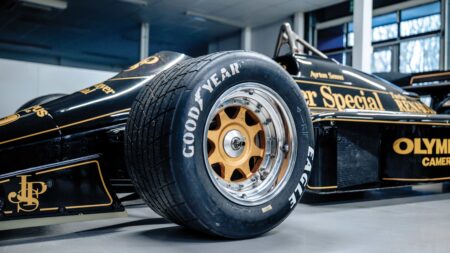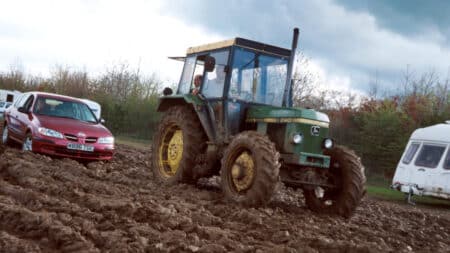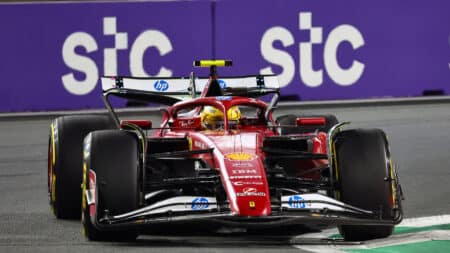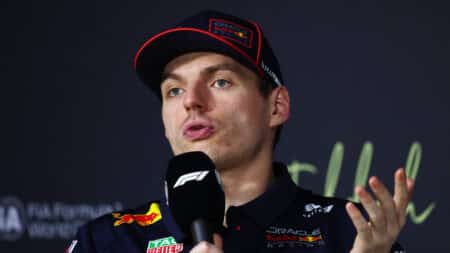
Senna's Lotus 97T: exclusive shoot of F1 legend's first winner
It's 40 years since Ayrton Senna's incredible first F1 win at Estoril – we captured the brilliant grand prix car he did it in for this month's magazine
Footage. Not the billion specks of memory imprinted on sanitised microscopic chips. Rather the reels of it stacked in dusty storerooms: analogue stuff that you can touch – if not rotted beyond repair.
We are suffused with info and images by today’s digitised immediacy. Every Formula 1 angle is covered in pin-sharp clarity. Spoiled by Red Button choice, however, most is sluiced into our mental Trash.
Rewind 60 years – when a black-and-white world occasionally blinked into soft-focus pastel – and footage’s increasing rarity means every millimetre of it is precious.
Some elements lassoed by it leap from the screen: his insouciance at the wheel. If movement is tranquility, as Sir Stirling Moss insists it is, then he was economical with it.
Then there’s that shock of wavy, verging on unruly, hair that reminds you just how young ‘The Boy’ was – before premature baldness and those wearing, tearing accidents aged him.
Other elements, however, only emerge after you have stared at the foreground, paused and rewound (old phraseology dies hard), and scanned the background.
For example, what caused that ugly dent behind Moss’s head? Nurdles in Padua and Pescara, plus a spin on the Radicofani Pass, account for the dings in the nose and tail of his winning Mercedes-Benz 300SLR but not the one in its left-hand streamlined fairing. Hmm, I must revisit passenger Jenks’s account of the 1955 Mille Miglia. Never a chore, that.
And not all of Stirl’s famous waves – nine parts thank-you, one part showing-off – were hail fellow well met: inexperienced Mike Young is left in no doubt precisely where he ought to be driving his F2 Connaught during the 1954 International Trophy at Silverstone.
Clips such as these hooked me into the Beeb’s recent Racing Legends programme about Moss much more than did the distinguished-thespian intonation and body language of Sir Patrick ‘Make it so!’ Stewart. A fan of Moss and cars, no doubt, he has, however, yet to recover from the shock of losing the command of Starship Enterprise. (Chef James Martin would do a better job, both in and out of the cockpit, of guiding us through Sir Jackie Stewart’s career.)
What else ‘Moss’ caught my eye?
The large amount of negative rear camber on his Mercedes-Benz W196; his bemused expression as he climbed from the bemusing MG EX.181 record-breaker at the always bemusing Bonneville; and the celebratory cigs jutting perkily from fingertip or drooping rebelliously from bottom lip, more by way of physical affectation than for their chemical effect.
His automated Mayfair shagpad in all its 1960s James Bond pomp, complete with admiring rent-a-blonde, and with a standard light’s shade still in its cellophane wrapper. (Never daft with his money is Moss.)
The sunken left eye, wobbling departure on crutches from Atkinson Morley Hospital and disembarking stumble from an aeroplane – all direct consequences of his 1962 career-ending shunt. The ‘disguising’ beard (an indirect consequence?) that suited him, and the “sissy” crash helmet he wore unbuckled as a 1948 motor sport fledgling.
The half-emptied grandstands like galleons in full sail at the storm-lashed 1950 Dundrod TT. His constant leaping and bounding: into a Jag and away; out of a Jag and away to congratulate winners Peter Collins/Pat Griffith at the 1952 Goodwood Nine Hours.
The mud at, and general unpreparedness of, the inaugural 1954 Aintree 200: Moss’s first win in an F1 car. The nervy backwards glance and unsure hand signal to team leader Juan Fangio as they gunned their Mercs to the chequered flag of the British Grand Prix at the same venue the following year. And the three attentive mechanics helping a ginger Tony Brooks from his Vanwall there two years later so that Stirling might hop in – and win again – and the scuff on the former’s crash helmet that bore testimony, I presume, to the recent inversion at Le Mans that was the cause of his discomfort.
Madding crowds and the barely restrained jostling – and, oddly, cheek-pinching – of the victors, i.e. often Moss, at race finishes. The powfagged look and ‘Phew!’ blowing of the cheeks as he rolled into the pits after his miraculous winning of the 1959 Nürburgring 1000Km for Aston Martin – he was never more tired than he was that day. And the pre-race ‘nervous’ yawn and jokey chat with Graham Hill at Goodwood in 1962 that would gather deepening meaning in life-threatening consequence not much more than an hour later and with decades of hindsight thereafter.
Today, of course, is the history of tomorrow. Insight didn’t start, nor did it stop, with the Received Pronunciation of British Pathé’s newsreels. A rubber ball of a man, eightysomething Moss’s determinedly disguised hobbling through the gates at Ferrari without assistance and Brooks’s understated support – beige anorak and a few bons mots – alongside Stirling as Stewart hesitantly took the wheel of a Vanwall were indicative still of the characters of Britain’s most famous racing driver and the greatest racing driver that most Britons have never heard of.
It was all there. You just had to scan and to stare – despite the improved picture quality.

It's 40 years since Ayrton Senna's incredible first F1 win at Estoril – we captured the brilliant grand prix car he did it in for this month's magazine

Twenty-five years ago, the British GP was the subject of a 'prank' by the powers that be as Bernie Ecclestone and Max Mosley made the BRDC hold the race on Easter Sunday. But the chaos that ensued didn't have the desired effect, as Matt Bishop recalls

Lewis Hamilton left Saudi Arabia in a downbeat mood after finishing 30 seconds behind Charles Leclerc. Like in 2024, the Briton is struggling to find answers

The 2025 Saudi Arabian GP delivered a pivotal shake-up in the title battle, as Piastri claimed victory in Jeddah to take the lead the lead in the standings. Here are the main topics from the fifth round of the season